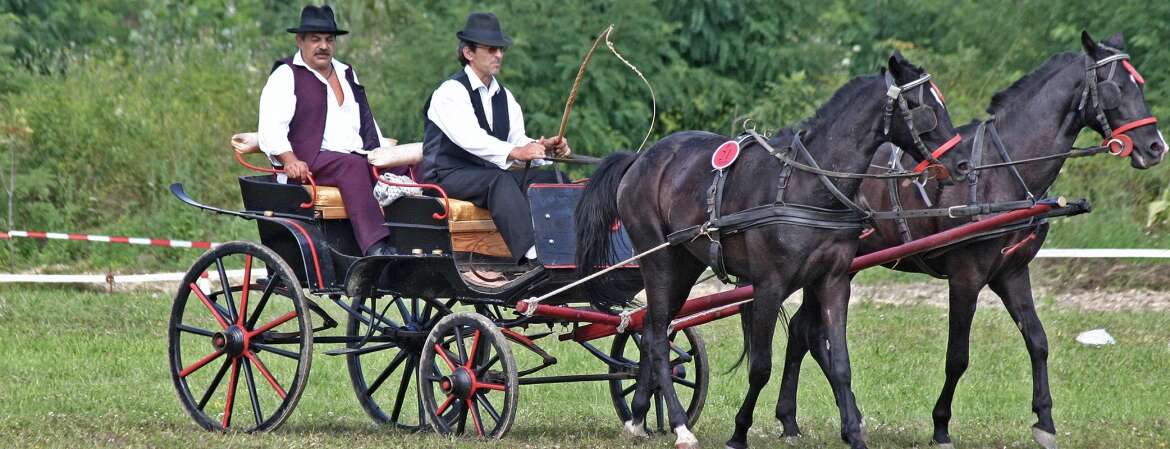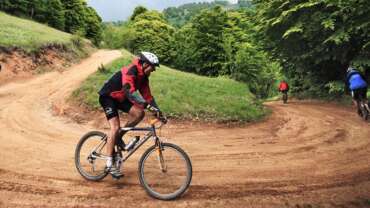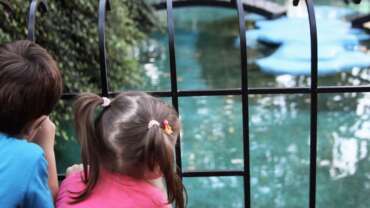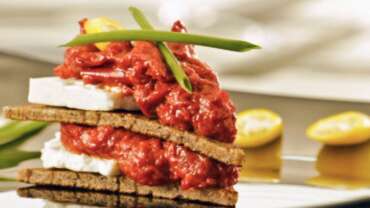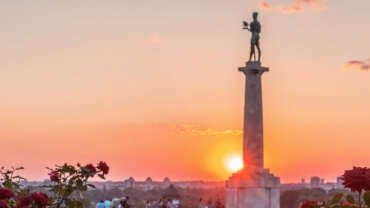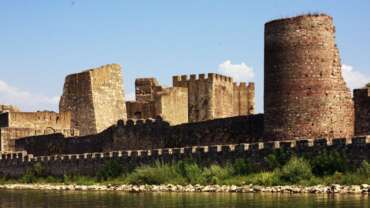Rural Retreats in Serbia
Virtually every village in Serbia has at least one rural retreat that will welcome you on your quest to explore undiscovered areas far from the urban hustle and bustle and the crowded tourist resorts, and yet close to national parks, nature parks, rivers, lakes, monasteries, archaeological sites…
Along with the well-known hospitality of your Serbian hosts and hostesses, you will have an opportunity to experience the full diversity of rural Serbia. Vojvodina in the north is recognisable for its “salaš” country houses, known for their richly laden dining tables and their love of horses. In Šumadija and Morava Valley, you will stay in carefully furnished households and typical “Morava-style” houses.
In the wine regions rural retreats will often have their own, well-stocked wine cellars. On the mountains of Western Serbia, you will rest inside cosy log houses with traditional wooden sleeping quarters known as “vajat”, while the distinctive feature of Eastern Serbia are the traditional mountain houses with porches on Stara Planina mountain.
For those who are unwilling to sacrifice comfort, Serbia offers small tourism complexes, complete with swimming pools and all other modern luxuries.
Wherever you go, you are sure to wake up to the sounds of nature, feast on delicious homemade food and freshly picked fruits and vegetables, learn about rural customs and traditions, discover places off the beaten path and, perhaps most importantly, meet some wonderful people.
Serbia awaits you with its rich and diverse rural tourism offerings.
Vojvodina
The rural households of Vojvodina reflect the unique blend of its history, gastronomy and family traditions and encompass the steady pace of life in the region. Nestled in the tranquil plains of Northern Serbia, for decades they have been welcoming tourists on a quest to find a place to relax and savour the authentic laid-back atmosphere of a Pannonian village.A stay in the villages of Vojvodina is guaranteed to relieve the stress and worries of your day-to-day life. The endless fields of wheat, maize and sunflower will help you reconnect with nature.In the households of Vojvodina, you can also enjoy a hands-on experience with domesticated animals and have a glimpse of daily rural life, while the hospitality and warmth of your host will make you feel at home. However, staying at village households is not all there is to rural tourism so be sure to visit the nearby nature sites and historic landmarks.
Nature Sites and Amenities
Fruška Gora National Park is a must-see picnic site for all those who visit Vojvodina. Take a walk along its verdant meadows lined with linden forests and relish the view of the orchards and vineyards spreading across its slopes. And then take a well-deserved rest at one of the local households on the sunny sides of this highest mountain of Vojvodina.
Villages near Zasavica Special Nature Reserve are ideal for one-day excursions to this protected wetland. Zasavica is home to many endangered bird species; a whole colony of beavers lives here, as well as numerous native species of domesticated animals, such as mangalica pigs, Podolian cattle and the Balkan donkey.
The village of Bački Monoštor near the city of Sombor lies at the entrance to Bačko Podunavlje Nature Reserve, a UNESCO Biosphere Reserve site. As the protected nature area is so close, you will be able to wander the expanse of pristine nature and enjoy the sight of black storks, herons or white-tailed eagles.
If you choose to stay at one of the several households in the lower course of the river Begej, don’t miss the chance to visit Carska bara, a wetland area with an unusually large population of the great cormorant.
If sandy terrain is more to your liking than wet habitats, then a holiday near Deliblato Sands Special Nature Reserve will be perfect for you. Apart from relaxation in the tranquillity of the rural environment, the village households in the nearby Deliblato also offer traditional horse carriage rides around the protected area.
And if you happen upon villages near the river Tisa, go down to the river and spend your holiday enjoying slow boat rides or fishing. This area is a magnet for tourists in June, when the river simply “blooms” with the “wedding dance” of the Tisa mayfly.
Landmarks
In the fertile plains of Vojvodina, where agriculture is the main source of income and the way of life for most of the population, there are numerous cultural and historic landmarks dedicated to crops, food and rural life.
With its permanent display which demonstrates the workings of old harvesters, mills, ovens and other tools and devices, “Jeremija” Bread Museum illustrates the journey a grain of wheat undertakes from the soil to the dining table.
Discover how the luxury fabric of damask used to be woven in the olden days at Europe’s last surviving silk damask weaving mill, situated near the city of Sombor. At the Beer Museum, discover first-hand the details of ancient methods of brewing, storing and distributing this popular beverage of choice for many. The permanent display is on the premises of the Zrenjanin Brewery and features the typical furniture and fixtures used by public houses a century ago, as well as the original documents, letters and photographs from the early decades of the brewery’s operation.
The Tractor Museum in Novo Miloševo displays the tractors and steam machines that have been used to cultivate land from 1920 to the present day. Here you will also find the tools used in ancient crafts, antique clocks, motorcycles and radio and TV sets.
Spend a weekend in the true Vojvodina atmosphere, on Perkov Salaš (Perko’s Farm) in the vast fields of Fruška Gora mountain. Over a glass of wine, local fruit brandy called “rakija” or homemade juice, here you can view the exhibits included in the ethnology collection and hand-crafted souvenirs. In the farm’s workshops you can learn how to make jams, fruit preserves or homemade juices and you hosts will also take you on a herb-picking trip to the surrounding countryside.
The Museum of Vojvodina Slovaks in Bački Petrovac will take you through the life of the Slovak people in the region. On display it has authentic Slovak folk costumes, old coins and documents, as well as a collection of natural history and arts.
Serbia’s sweetest museum is found in the city of Sremski Karlovci. It is dedicated to the Gugelhupf, an unusually shaped dessert. At the Gugelhupf Museum, you can discover the tools used to make and eat the Gugelhupf and also learn how to make this treat which was once reserved for the dinner tables of kings and European nobility.
Food
The rural households across Vojvodina make food from home-grown produce, which you can often pick yourself at the local gardens or orchards.
The multi-ethnic spirit of Vojvodina is also reflected in its cuisine: local households will often serve you a variety of European dishes from different cultures, including the German grenadiermarsch or the traditional Hungarian dishes, goulash and satarash, as well as the Serbian mangalica pork paprikash, the Slovakian “herovke” or the Ruthenian schnitzel. In the villages around Sombor, you can relish the flavours of the unique Bunjevac cuisine, where the “large farmer’s dish” and the tasty potato pie with sausages and cabbage take centre stage. For a taste of bacon made according to a special recipe, go to the village of Kačarevo in Banat.
The Hunting Manor in Ečka serves game dishes, as well as fish specialties, among which the Ečka carp comes highly recommended. In the villages on the banks of the Danube you can taste the unique dishes made by river fishermen, including gourmet fisherman’s soups and paprikash spiced with lots of paprika, a spice that is lovingly produced all over Vojvodina.
Wash down the main meal of the day with one of the native Serbian varieties of Vojvodina wines. In Sremski Karlovci, the viticulture centre of the region, you can taste an authentic aromatised wine with spice herbs, the Karlovac Bermet. Or sample the famous “sand wines” made from vine grown in the Subotica-Horgos Sands, such as Kadarka. In the villages near the city of Senta, surrounded by orchards and vineyards, you can taste different types of fruit “rakija” – slivovitz (plum brandy), apricot brandy and quince brandy.
Western Serbia
The mountains and gorges of Western Serbia are a true oasis of tranquillity and harmony. Here you can rest in the traditional wooden houses called “vajat” and log cabins, hike along mountain ranges or sail down rivers through deep canyons which stun visitors with their beauty.Walk around the raspberry farms of the Arilje region and pick the famous fruit that is exported all over the globe. Step into the thick plum orchards near Osečina or discover one of the many ethno villages scattered along the mountains of Southwestern Serbia.Whichever direction you choose, you are sure to experience a true feast for the senses!
Nature sites and landmarks
Tara National Park is filled with natural beauty – from the thick coniferous forests to the rivers, waterfalls and the deep canyon of the Drina. In the winter the mountain’s modern ski resort attracts skiers of all ages and skill levels. And in the summertime, you can explore every corner of this beautiful mountain on its maintained hiking and cycling trails. Another interesting way to discover Tara is from the river Drina, which is ideal for kayaking and rafting, as well as fishing.
If you choose to stay at the rural households on Zlatibor mountain or in the town of Ivanjica, you will experience the many benefits offered by these two fresh air spas. If you join the herb picking tours of Zlatibor, you can learn all about the herbs used in the making of cosmetic products and teas.
The gorges on the rivers Gradac and Trešnjica attract fishermen, in their droves, throughout the year as they are ideal for fly fishing in rapid waters. Their canyons also provide the perfect backdrop for photos. Near the river Trešnjica, you can also enjoy watching some twenty couples of endangered griffon vultures.
With a vertical drop of more than 30 metres, Skakalo waterfall is one of the most beautiful landmarks of Maljen mountain. As the waterfall is on inaccessible terrain, reaching it is no small feat, but your efforts will be rewarded with an opportunity to kick back and enjoy the sonorous murmur of the cascading waterfall and the surreal splendour of the surrounding nature.
If you stay at a rural household near Divčibare, do not miss Ribnica cave, best known for being home to as many as 15 bat species.
The slopes of Zlatibor mountain hide another speleological gem – Stopića cave. As you walk along the lit footpaths inside the cave, your eyes will inevitably be drawn to the large tufa pools – recesses in stone separated by undulating stone walls which fill with water. The water then overflows from pool to pool, creating cascades and waterfalls with vertical drops as high as nine metres.
Landmarks
In Tršić, the birthplace of Vuk Stefanović Karadžić, the reformer of the Serbian language, there is an ethno complex comprised of 35 protected structures. Original houses, traditional wooden cabins, watchtowers, barns and a wooden church will give you a glimpse into the life of the people of this region in the 18th and 19th Centuries.
In the village of Zlakusa, near the city of Užice, you can spend your holiday in an authentic rural environment surrounded by numerous orchards, raspberry farms and blackberry farms. You can also try your hand at making pottery the traditional way.Here you can witness how the skilful hands of rural potters make vases, crocks and cooking pots out of lumps of clay, using calcite as an adhesive. The pottery of Zlakusa is held in high regard all over Serbia because of its beauty and durability. They also say that food cooked in this earthenware has a special taste.
The Open-Air Museum in Sirogojno features authentic log cabins and ancillary buildings, constructed in the 19th century, which were carried over from the nearby villages on Mt. Zlatibor. Experience the spirit of a bygone era by visiting traditional Serbian households, workshops, drying kilns, stables and sheep enclosures, while enjoying the benefits of the fresh Zlatibor air.
The tourist settlement of Drvengrad on Mećavnik mountain is an ideal combination of an authentic ambience, superb gastronomy and masterful works of art and culture. Stay at one of the Dinaric-style houses and restore your energy by treating yourself to traditional local dishes or walk along the streets and squares named after some of the world’s greatest filmmakers and actors. In January, during the Kustendorf International Film and Music Festival, Drvengrad becomes a film capital, while every June brings an opportunity to enjoy the Bolshoi Festival of Russian Music.
Food
The region of Zlatibor has become almost synonymous with quality cured meat products. During your stay in the villages on Zlatibor you will be treated to cured sausages, cured pork tenderloin and bacon. The best-known of the dry-cured meats is the veal ham from Užice (“užička pršuta”), which has a protected designation of origin, made from pure veal cured in a beech wood fire.
To honour the delicious veal ham, a “Pršutijada” (Ham Festival) is traditionally held every year in the village of Mačkat on the slopes of Zlatibor. Be sure to visit for a taste of the dry-cured meats made by local producers.
A special place in the gastronomy of the Užice region belongs to the famous “komplet lepinja” (a flat bun with eggs), “kajmak” (similar to clotted cream) and pork dripping, which has become a staple of this part of the country.
The most famous delicacy of the Valjevo region, “tobacco” pork cracklings, is recognisable for its golden-yellow, paper-thin pieces of meat resembling tobacco. Dishes of the Ivanjica region you should make sure to try include baked potatoes filled with bacon, cheese and “kajmak”, as well as “čajce”, straight dough pastry filled with cheese and “kajmak”.
Be sure to wash it all down with “šljivovica”, the traditional Serbian alcoholic drink made of plums.
There are roughly one million plum trees in the villages around Osečina and almost every household makes their own “šljivovica” brandy, made according to the traditional recipe, as well as jams, fruit preserves as well as prune or plum cakes.
The rural households in the Arilje region are among the world’s largest raspberry producers. Raspberries from this region can be found on dining tables all over the world, however here you will have the opportunity to taste them when freshly picked. You will also be treated to many delicacies made with raspberries, including raspberry cakes, chocolate-coated raspberries and raspberries in honey.
Central Serbia
Famous for is many forests – indeed, its very name, Šumadija, is derived from šuma, Serbian for forest – Central Serbia is perfect for holidays and relaxation in a rural environment.Here, you will sleep soundly in the authentic houses of Šumadija, on farms where ancient domestic animals are bred, while your generous hosts serve you roast meat and sauerkraut. Relax with a sip of homemade wine or “Šumadija Tea” – rakija boiled with water and caramelised sugar – and enjoy the view of fertile vineyards, orchards and farmlands.
Be sure to enrich your stay in the villages of Central Serbia by visiting the many natural and cultural landmarks of the area.
Natural Resources and Attractions
The roads along the slopes of Rudnik mountain are dotted with numerous households which provide rural tourism services, in reconstructed authentic houses, with healthy food and clean water from local springs. At the Veliki Šturac Nature Reserve, take a stroll through a very rare ancient forest community of beech woods, some of which are more than 300 years old.
A walk on the forest paths is sure to make your stay even more interesting, while scaling the mountain’s peaks will pose a challenge all true mountaineering aficionados will find hard to resist. Bear in mind, though, that the sharp peak of the volcanic cone named Ostrovica is extremely difficult to conquer and scaling it is not recommended unless you are an experienced climber.
Nestled on Suvobor and Rajac mountains there are several villages from which you can set off to explore the natural assets of this region. Find refuge on Rajac mountain, away from the urban hustle and bustle, and discover the natural beauty which earned it its name – derived from raj, Serbian for paradise.
The lush meadows full of native Serbian plants have inspired the local population to hold the famous annual Rajac Scythe Festival, where participants contend for the title of the best mower, with plenty of foods, merry music and supporting events. Rajac mountain also has one of the most beautiful viewpoints in Serbia, with excellent views of all parts of the country.
And if you wish to discover the very heart of Serbia, stay at one of the households around the village of Drača near the city of Kragujevac, which sits right at the geographical centre of our country!
With their maintained trails and exquisite scenery, Gledić mountains are a favourite destination with domestic and foreign mountaineers and cyclists alike.
Due to its exceptional plant and animal diversity, Golija mountain and its surrounding area has been declared a UNESCO Biosphere Reserve. As you stay at the nearby villages, you will be surrounded by more than a thousand different plant species and as many as a hundred species of birds. Golija mountain welcomes you with maintained ski slopes and ski lifts, hiking and fitness trails and paragliding sites.
Not far from Golija mountain flows the river Ibar. Every year it hosts the Merry Race, an event that brings thousands of visitors to sail down the river accompanied by music, beautiful weather and merriment.
The valley of the river Ibar is often called the Lilac Valley, a nickname it earned in the Middle Ages, when King Uroš I ordered lilacs to be planted along the valley to remind his future wife, Helen of Anjou, of her homeland Provence.
Landmarks
Grapes have been grown in the fertile plains around the town of Topola since ancient times. The region experienced a true renaissance of winemaking with the opening of the Venčac Vineyard Cooperative during the reign of King Peter I. The former royal winery, now the Royal Winery Museum, keeps decades-old exclusive wines from all over Europe, antique wine pumps and other tools, as well as wine cask, the oldest of which was made in 1909.
The village of Bela Voda near Kruševac is the extraction site of exquisite sandstone, used in the construction of numerous Serbian monasteries. It also has a Stone Masonry and Sculpture Museum of the Morava Style, where you can see numerous sculpture exhibits, photographs of buildings made from this sandstone and the famous stone rosettes of Bela Voda.
In the village of Lipovac you can see a unique natural and historic monument – the Sacred Oak. Legend has it that the oak was the gathering site of rebels during the First Serbian Uprising against Ottoman Turks and science has confirmed that this richly ramified oak is more than 300 years old.
Food
The cuisine of the region around the city of Kragujevac is mainly based on sauerkraut, with dishes such as smoked ham in sauerkraut, boiled wedding cabbage with meat, onions and spices, as well as podvarak (sauerkraut, first fried and then baked, served with pork or turkey meat).
Lamb and veal roasted under a metal or ceramic lid (pod sačem)and homemade wine are seen as a match made in heaven and an indispensable part of any festivity in this region.
A typical beverage of Central Serbia is the “Šumadija Tea” – šljivovica boiled with water and sugar, to warm the body and boost immunity.
Villages around Bukovička Banja spa will welcome you with roast meat and proja, a corn bread mixed with mineral water, while at Vrnjačka Banja spa you can taste Vrnjci, a mineral water with a protected origin designation.
Owing to extensive cattle farming on Goč mountain near Vrnjačka Banja spa, almost every household in the area has a supply of fresh milk, which they use to make the famous Goč cheese and kaymak, a kind of clotted cream. Your hosts will serve you these dairy delicacies with hot buns made from dough mixed with mineral water and wild garlic.
Central Serbia also has several wine regions, with many family-run wineries which produce homemade wines from grapes grown in their vineyards. In the villages on the banks of the river Toplica, you can sample a variety native to the region, Prokupac, which produces a ruby-coloured wine.
In the villages of the Aleksandrovac Wine Region, be sure to taste Tamjanika, an ancient grape variety typical of the area, which produces a wine that’s easy on the palate. It has a striking aroma and flavour, with spicy notes of cinnamon, basil and thyme (tamjan),to which this variety owes its name.
Eastern Serbia
The region of Eastern Serbia has always had an air of secrecy and mystery about it.
The bank of the Danube in the far east of the country has been populated by humans for more than 9,000 years since the age of the Lepenski Vir culture, which once flourished here. While much has changed since then, the harmony between the way of life of the local populace and nature has remained untouched.
The rural households in this area are highly diverse. Some of them lie on the very bank of the Danube and are a true paradise for fishermen and fish gourmets alike. Other households are perched on mountain slopes and are ideal for hiking, skiing, mountaineering and conquering the challenging mountain peaks. Others still are situated in the vicinity of medical spas and important historic landmarks.
Regardless of location they all offer an authentic stay, which is sure to rejuvenate you and help you return to your daily life ready for fresh challenges.
Natural sites and attractions
Eastern Serbia flourishes with natural beauty. In the north-eastern part of Serbia, where the Danube is at its deepest, lies the Đerdap National Park, with the majestic Iron Gate Gorge, one of the longest gorges in Europe.A view of the steep cliffs of the gorge from the Danube is breath-taking. Equally fascinating is the fact that this area is home to more than 1,100 plant species and there are more than 200 bird species flying over the forge, including some rare ones such as the golden eagle, the white-tailed eagle, the black stork and the grey heron.
The number of small waterfalls in this region are the favourite picnic spots of both locals and tourists. Visitors to the village of Mokrinje have an opportunity to enjoy pristine nature at the Mokranjske stene picnic area, with its small waterfall and picturesque lake.
Two mighty emerald-green springs, the Mlava and the Kupajsko vrelo, gush from the limestone rocks of Beljanica mountain. The mountain is also home to the protected natural monument of Lisine, with its cascading waterfall with a vertical drop of more than 20 metres.
Active holiday lovers will enjoy hiking along Stevanske livade meadows on Deli Jovan mountain, while the most hardy mountaineers will be rewarded with stunning views of the entire region of Negotin from the mountain’s peak.
If you choose one of the villages in the Soko banja region as your base, you will be able to take a trip to one of Serbia’s favourite spas, which offers numerous individually designed wellness and fitness programmes.
You can also have a relaxing holiday at Ždrelo, Serbia’s youngest spa. This modern spa resort, offering massage, saunas and swimming pools, also features an aquapark, which will be greatly enjoyed by any young visitors.
Get to know the rich plant and animal life of Stara planina mountain, one of the centres of biodiversity in Serbia. There mountain, which remains covered in snow for several months of the year, boasts a skiing and tourist resort. Conquering its highest peak, Midžor, is a challenge for even the most experienced climbers.
Rtanj, an unusual, cone-shaped mountain, is of particular interest to herb pickers as winter savory, a widespread plant species used in the making of the Rtanj tea – a beverage known for its potent flavour and aroma – grows in abundance.
Landmarks
On the slopes of Stara planina mountain lies the village of Gostuša, a unique architectural area. Everything in Gostuša – houses, roofs, fences – is made of stone, earning it the nickname of Stone Village. The original 19th-century houses, very well preserved, are still inhabited by villagers, who live their life in harmony with nature.
A magnificent 19th-century building designed in the Oriental Balkan style is home to the Museum of Ponišavlje (the Nišava river basin), which displays authentic furniture and household items of the Pirot region. Much of the museum is dedicated to the colourful handmade carpets (the “Pirot kilim”) for which this city has become widely known.
A unique blend of traditional folk architecture and exhibits, dating back to classical antiquity, can be seen at the Archaeological Ethno Park in the village of Ravna, near the town of Knjaževac. The building of the former village school hosts a display of items found on the nearby Roman archaeological site Timacium Minus. Here you can also see original houses, workshops and ancillary buildings built in the 19th Century, which were carried over to the park from the nearby villages.
The Negotin region is renowned for its many wine cellars, known locally as “pivnice” or “pimnice”, which are densely concentrated on a relatively small geographic area.In the hills near the village of Rajac, there is a whole village of more than 270 wine cellars. Built of stone and covered with semi-circular grooved roof tiles known as “ćeramida” and with cellars dug up to one metre into the ground to preserve even temperature, the local wineries, known as “Rajačke pimnice“, have been storing large quantities of wine for centuries.
Around the village of Rogljevo, there are more than 150 wine cellars, most of them built in the 19th century. Together with the winding streets and the assembly square, they form a unique architectural area.
Some of the authentic wine cellars of Rajac and Rogljevo have been renovated and converted into modern hospitality establishments, ready to welcome visitors from all over the world. Use your visit to the wine cellars to sample or buy some of the delicious homemade wines.
Food
In the villages near the Danube, you will be treated to freshly-caught freshwater fish prepared in a myriad of ways – boiled, baked, fried and breaded. A speciality of the region is marinated northern pike. A traditional dish of the Veliko Gradište area is the native Serbian variety of beans called “gradištanac”, which can be served both lean or fatty.
The area around Negotin is one of Serbia’s main wine regions. The local wine cellars store wines of Prokupac, Smederevka, Game and other varieties. This is also the only region in Serbia where Black Tamjanika, a native Serbian grape variety which produces wines with an intense flavour and fruity, spicy aromas, still grows.
In the high Homolje mountains beekeepers produce honey with a designated geographic origin, which owes its unique taste to native plant species which grow where bees are left to forage.
The Homolje region is home to the Vlach national minority, whose members cherish the traditional dishes of their ethnic cuisine. Thus, here you can taste authentic Vlach dishes such as sour chicken soup, cornbread with nettle and mamaliga polenta served with meat.
Do not leave the region of Pirot until you have tasted the Pirot caciocavallo cheese which simply melts in the mouth. Also, not to be missed is the famous flat sausage from Pirot. Cheese lovers will also enjoy the Stara planina caciocavallo cheese, made from the milk of cows and ewes bred on Stara planina mountain.



